Mitu F.1, Ţurcanu Adina Magdalena2, Cojocaru Clementina3, Dima Cozma Corina4
Articol primit pe data de 21 martie. Articol acceptat pe data de 23 iunie.
1,3,4 University of Medicine and Pharmacy “Gr.T.Popa” Iaşi Faculty of Medicine Medical Department I
1,4 Clinic for Cardiovascular Recovery, Iasi Recovery Hospital
3 Clinic for Cardiovascular Recovery, Iasi Recovery Hospital
2 Clinic of Pulmonary Diseases Iasi
Dr. Adina Gheorgita, University of Medicine and Pharmacy “Gr.T.Popa” Iaşi Faculty of Medicine, Medical Department I
E-mail: adinagheorghita@yahoo.com
Abstract: Objectives – Retrospective evaluation of lipidic profile and of the main demographic characteristics of smoking patients hospitalized in Recuperation Cardiovascular Clinic of the Recuperation Hospital from Iasi over a period of 6 months. Methods – 100 smoking patients confined in succession between January 2009 – July 2009. The analyzed data included: demographic parameters, quantification of tobacco consume (packs year), lipidic profile (HDL cholesterol, LDL cholesterol, total cholesterol, triglycerides), glycemia and atherogenic parameter. Results – In the studied group, the majority of smoking patients were males (72 patients), from urban medium (63 patients) and had between 40-60 years; 44 patients were considered great smokers, with a consume of cigars between 21-50 packs year. The analyze of lipidic profile revealed 4% smokers with hypercholesterolemia, 51% smokers with hipertriglyceridemia and 45% with mixt dislipidemia. Positive correlations were demonstrated between the masculine gender and a great number of Packs-Year – total cholesterol – seric triglycerides, masculine gender and great number of Packs Year – urban medium, between Packs Year and grown values of lipidic profile. No correlation was found with the values of basal glicemy, which were in the normal range. Conclusions – smoker status at patients with relative young ages, of masculine gender, induce the modification of lipidic profile in a atherogen way, leading to an important supplementation of the cardiovascular risk and a negative prognostic on long term.
Keywords: smokig, cholesterol, triglycerides, cardiovascular risk
Rezumat: Obiectivele studiului – Evaluarea retrospectivă a profilului lipidic şi ale principalelor caracteristici demografice ale pacienţilor fumători internaţi în Clinica de Recuperare Medicală Cardiovasculară a Spitalului Clinic de Recuperare Iaşi, pe o perioada de 6 luni. Material şi metodă – În studiu au fost incluşi 100 de pacienţi fumători, internaţi consecutiv în perioada ianuarie 2009-iulie 2009. Datele prelucrate au fost extrase din foile de observaţie și au inclus: parametri demografici, cuantificarea consumului de tutun (pachete-an), profilul lipidic seric (colesterol total, HDL-colesterol, LDL-colesterol şi trigliceridele serice), glicemia bazală şi indicele de aterogenitate. Rezultate – În lotul studiat, majoritatea pacienţilor fumători au fost de sex masculin (72 pacienţi), proveniţi din mediul urban (63 pacienţi) şi s-au încadrat în grupa de vârstă 40-60 de ani; 44 de pacienţi s-au încadrat în categoria de mare fumător, cu un consum de ţigarete între 21-50 pachete-an. Analiza profilului lipidic a relevat un procent de 4% fumători cu hipercolesterolemie, 51% cu hipertrigliceridemie şi 45% cu dislipidemie mixtă. S-au demonstrat corelaţii pozitive între sexul masculin şi valori crescute ale PA- colesterol total-trigliceride serice, sexul masculin şi numărul mare de PA- mediul urban, între PA și valorile crescute ale profilului lipidic. Nicio corelaţie nu s-a putut demonstra cu valorile glicemice bazale, care au fost situate în limitele normale. Concluzii – Statusul de mare fumător la pacienţi cu vârste relativ tinere, de sex masculin, induce modificarea profilului lipidic în sens aterogen, determinând o suplimentare importantă a riscului cardiovascular şi un prognostic nefavorabil pe termen lung.
Cuvinte cheie: fumat, colesterol, trigliceride, risc cardiovascular
Introduction
Smoking is a habit which generates dependency between the consumers of tobacco. The sequel of this behavior appear in all the body, at different levels, and determine a series of cardiovascular, pulmonary, neoplazic diseases etc.1 The cardio-vascular sickness, determined by smoking has been studied intensively in the last years because of the serious effects associated with the consume of tobacco, but also with the growing number of smokers among both women and men.
The level of dependence to nicotine varies and it can be quantified through different methods which include a series of tests (eg. «The Fagerstorm Test for Nicotine Dependence») or the dozing in blood of the level of nicotinemia and its main metabolites. The number of smoked cigars does not represent an exact method of evaluation of the dependence or of the total consume of tobacco whereas a smoker will almost always have the tendency to subreport the number of smoked cigars.2
Numerous studies pointed out the implications of smoking on the cardiovascular function. Rises of LDL cholesterol and triglycerides, the dropping of HDL cholesterol have been observed at smokers. These values are associated with the apparition of hypertension, the presence of the atheroma plates, the rising of the incidence of cases of myocardial infarction, vascular cerebral accidents, embolism and thrombosis, the affectation of peripheral vascular circulation.3,4
Material and method
This retrospective study included 100 patients confined in succession in the Recuperation Cardiovascular Clinic of the Recuperation Hospital from Iasi, in the period 1st of January 2009-1st of July 2009 (6 months).
Criterions of inclusion in the study-the status of smoker, the absence of the antilipemiant treatment in the last 2 months; sex or the medium of residence were not a criterion of exclusion.
For each patient included in the study, there have been checked the values of HDL cholesterol LDL cholesterol, total cholesterol, triglycerides, atherogenic parameter, glycemia, number of smoked cigars, the status of alcohol consumer and the principal qualitative characteristics represented by age, sex, medium of residence.
The quantification of tobacco consume was noted under the form «No. of packs on year » (no. PA) and it was realized with the formula number of smocked packs/day X number of years=number of packs on year.2
The status of alcohol consumer could not be quantified through a certain formula because of the incomplete data from the observation sheets, but the patients were classified in three categories: chronic alcohol consumer, the one was denying the consume of alcohol, occasional alcohol consumer.
The data management was realized through direct correlations between the values of the lipidic profile and the status of smoker, age, sex, medium of residence. The results have been calculated numerical and procentual, being exposed in the shape of figures and tables, statistic analyzed in SPSS.
Results
After studying the 100 smokers, confined in the Recuperation Cardiovascular Clinic in Iasi, it has been observed that the number of feminine patients is almost with 40% lower that the one of masculine ones, respectively 28, compared to 72 persons (Figure 1).
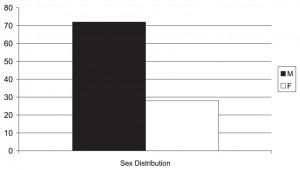
Figure 1. The distribution by gender of smoking patients hospitalized at Iasi Clinic for Cardiovascular Recovery between January 2009 – July 2009.
In what concerns the repartition of confinements related to the medium of residence, it is pointed out that is a number almost double of sick people coming from the urban medium, compared to those who come from the rural one. This thing can be translated through a difference of approximately 63% between the two areas. The number of patients from the urban medium was of 63, compared to the one in the rural medium, who was of 37 (Figure 2). The statistic analysis also showed a positive correlation (r=0,23, p=0,02) between the number of PA consumed and the medium of residence (urban) at all the studied, confined sick persons. (Table 1). At the same time it could be demonstrated a correlation (r=0,306, p=0,09) between PA and the urban medium of residence at the masculine sex (Table 2). This thing could not be pointed out at the feminine sex.
Table 1. Correlations between Packs Years and the urban medium of residence at all patients

Table 2. Correlations between Packs Year and urban medium of residence at all male patients

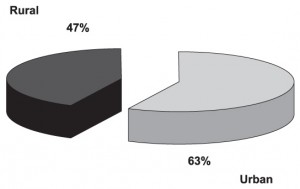
Figure 2. The distribution of smoking patients hospitalized at Iasi Clinic for Cardiovascular Recovery between January 2009 – July 2009 by medium of residence.
The repartition of smoking patients referring to the age groups pointed out the fact that the most confined ill persons had ages between the decade 50-60 years (56 patients), followed by the ones in the decade 40-50 years (19 patients). In the other age decades it was registered a similar repartition of the number of patients. It can be observed that only six patients had more than 70 years (Figure 3). It could not be demonstrated any correlation (r=0,03, p=0,97) between the number of PA and the patients’ age from the studied group.
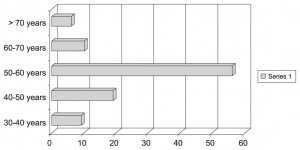
Figure 3. The distribution of smoking patients hospitalized at Iasi Clinic for Cardiovascular Recovery between January 2009 – July 2009 by age groups.
Regarding the number of patients reported to the smoked packs of cigars it can be seen that the majority of the confined ones (56 patients) smoke between 1-20 packs/year. Also, there are eight persons who smoke over 50 packs/year – a similar number to those who consume between 41-50 packs/year. (representing together 15% of the sick people included in the group) (Figure 4).
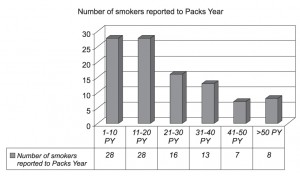
Figure 4. The distribution of smoking patients hospitalized in the Recuperation Cardiovascular Clinic Iasi between January 2009 – July 2009 by the packs year smoked.
The study of the status of alcohol consumer revealed the fact that 41 patients recognize the occasional consume of alcohol, 25 recognize the chronic consume and 36 deny the alcohol consume. In this way it can be observed a tendency to associate the tobacco consume with the alcohol one, even in varied quantities. (chronic/occasional).
The studied biochemical analyses were realized in the laboratory of Iasi Recuperation Hospital. The normal values considered were: triglycerides <150 mg/dl, total plasmatic cholesterol <190 mg/dl, HDL cholesterol <40 mg/dl at men and <50 mg/dl at women, glycemia <100 mg/dl, aterogen parameter <4.
The analyses of the values of triglycerides at each patient pointed out that over 50% from the persons included in the study had values over the superior limit of normality. Thus, it has been observed a number of 57 patients with hypertriglyceridemia (Figure 5).
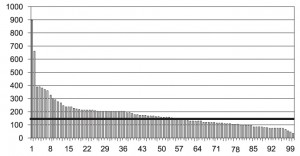
Figure 5. The distribution of smoking patients hospitalized at Iasi Clinic for Cardiovascular Recovery between January 2009 – July 2009 by the triglycerides values (mg/dl).
At the same time, the repartition of patients in terms of the value of triglycerides and the number of packs/year revealed a rising of values of triglycerides which can be obviously associated with a bigger consume of packs/year (Figure 6).
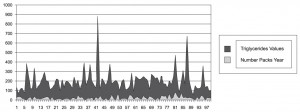
Figure 6. The distribution of smoking patients hospitalized at Iasi Clinic for Cardiovascular Recovery, between January 2009 – July 2009 by the triglycerides values reported at the number of packs year.
The analyses of the values of the glycemia at the patients included in the study did not revealed a predisposition to raised values of this and a correlation with the status of smoker was not possible.
The study of the total cholesterol showed that from 100 smoking patients confined in the period 1st of January 2009-30th of June 2009, 68 had raised values of the total cholesterol over 190 mg/dl (Figure 7). Reporting the number of packs/year at the values of the total cholesterol it was observed a raise of the values of the total cholesterol, being recorded values of over 250 mg/dl. Also, it is pointed out a number of 10 patients with values of the total cholesterol very close to the superior limit of normal (Figure 8).
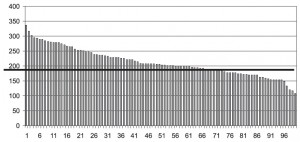
Figure 7. The distribution of smoking patients hospitalized at Iasi Clinic for Cardiovascular Recovery between January 2009 – July 2009 by the cholesterol values (mg/dl).
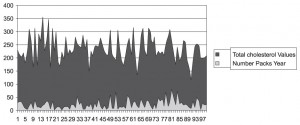
Figure 8. The distribution of smoking patients hospitalized at Iasi Clinic for Cardiovascular Recovery between January 2009 – July 2009 by the cholesterol values reported at the number of packs year.
In what concerns the correlation of cholesterol values with the ones of triglycerides it has been observed an association of raised values of total cholesterol with the raised values of triglycerides. It is observed that over 45 of the smoking patients included in the study have mixt hiperlipoproteinemy, associating the abnormal values of both components (Figure 9). According to the statistic analysis, the raised values of triglycerides associated with the raised values of cholesterol (r=0,243, p=0,015) (Table 3). The calculated aterogen parameter has exceeded the normal value (4) for the majority of the patients included in the study.
Table 3. Correlations between the values of cholesterol and triglycerides at patients from the studied group

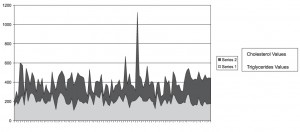
Figure 9. The distribution of smoking patients hospitalized at Iasi Clinic for Cardiovascular Recovery between January 2009 – July 2009 by the cholesterol values and triglycerides values.
Also, the statistic management of data revealed a correlation of medium power (r=0,367, p=0,001) between the number of PA consumed and the raised values of cholesterol and triglycerides at all the patients included in the study (Table 4). In terms of sexes repartition, the number PA is positively correlated (rPA – trigliceride=0,367, pPA – trigliceride=0,01; rPA – colesterol=0,341, pPA – colesterol=0,03) only at the sick men with the levels of seric triglycerides and of total cholesterol (Table 5). It could not be demonstrated any relation (rPA – colesterol=0,03, pPA – colesterol=0,98 ; rPA – trigliceride=0,322, pPA – trigliceride=0,101) between the number of PA- the raised values of the lipidic profile at women (Table 6).
Table 4. Correlations between the number of Packs Year and cholesterol values at all patients

Table 5. Correlations between the number of Packs Year- cholesterol- triglycerides at masculine gender

Table 6. Correlations between the number of Packs Years- cholesterol- triglycerides at feminine gender

Another positive correlation (r=0,267, p=0,023) could be observed between the raised values of seric triglycerides and of total cholesterol and masculine sex (Table 7). In the case of feminine patients it could not be demonstrated any correlation between sex and the raised values of the lipidic profile.
Table 7. Correlations between cholesterol and triglycerides values and masculine gender

From a statistic point of view, it was analyzed if there are statistic semnificative differences between the raised values of total cholesterol and seric triglycerides related to the medium of residence (urban vs rural). For this thing, it was applied a specific test (Independent Samples Test). The values obtained, coefficient Fischer Fcolesterol=1,375, pcolesterol=0,244 and Ftrigliceride=1,379 and ptrigliceride=0,243 revealed that there is no direct correlation between the medium of residence and the dislipidemic metabolism.
Conclusions
In the period 1st of January 2009-1st of July 2009 have been confined 100 smoking patients in Recuperation Cardiovascular Clinic of the Recuperation Hospital from Iasi.
The majorities of the people are men, come from the urban medium and are between 40-60 years old. It has been observed a tendency to associate the status of smoker with the one of chronic/occasional alcohol consumer.
Over a half of the confined patients are consumers of maximum 20 packs-year, but there were identified also chronic consumers of a number larger than 40 packs/year. The values of total cholesterol and triglycerides overrun the normal limit at the majority of the confined patients in the studied period. 45 sick people had mixt hiperlipoproteinemya. The values of total cholesterol and triglycerides tend to grow concomitantly with the raising of the number of consumed packs/year. There have been demonstrated positive correlations between the masculin sex and raised values of PA-cholesterol-triglycerides, masculine sex and PA-urban medium, between PA and the raised values of lipidic profile.
Discussions
The associations between the modifications of the lipidic profile and the status of smoker predisposes to the apparition of cardiovascular diseases.5-8 The patients’ age points out the fact that cardiac diseases tend to appear to younger persons (<50 years) and to be associated with unfavorable diagnosis of long term evolution. The analysis of the repartition on sexes of confined sick persons shows a number almost double of men, which confirms the hormonal protection of women, correlated with the more belated apparition of cardiovascular diseases, even at smokers. Although there was not found data to show a modification of glycemic profile at the patients from the studied group, there is data in literature which associates smocking with modifications of glycemia.6
Another important aspect is the fact that once the quantity of tobacco rises (quantified through packs/year), more accentuated modifications of the lipidic profile are recorded. The atherogen parameter calculated at the patients included in the study had values situated over 4, indicating the presence of atheromatosis modifications at different levels. In this way, it is confirmed the hypothesis conforming to which the vicious smokers associate a larger risk of apparition of acute coronarian events, compared to an occasional smoker or a non-smoker.7,9
Taking into account the young age of the sick, confined people with diagnosis of cardiovascular diseases in Recuperation Cardiovascular Clinic from Iasi, we can point out the necessity of the programs for giving up smoking, the programs of patient’s education and cardiovascular rehabilitation and also the precocious initiation of the treatment of dislipidemy with atherogen risk, this activities representing an important step in the prevention of cardiovascular acute events, often as a consequence of frequent tobacco consume.
Bibliography
1. Zatu MC, Van Rooyen JM, Schutte AE. Smoking and vascular dysfunction in Africans and Caucasians from South Africa. Cardiovasc J Afr. 2011 Jan-Feb;22(1):18-24.
2. Cojocaru C., Cojocaru E., Mihaescu T.. Pneumologie. Editura DAN, 2010.
3. Bišanović S, Mehić B, Sivić S.. Status of lipids and the frequency diseases of cardiovascular origin in smokers according to the length period of smoking and a number of cigarettes smoked daily. Bosn J Basic Med Sci. 2011 Feb;11(1):46-51.
4. Meenakshisundaram R, Rajendiran C, Thirumalaikolundusubramanian P. Lipid and lipoprotein profiles among middle aged male smokers: a study from southern India. Tob Induc Dis. 2010 Oct 5;8:11.
5. Grover SA, Kaouache M, Joseph L, et al. Evaluating the incremental benefits of raising high-density lipoprotein cholesterol levels during lipid therapy after adjustment for the reductions in other blood lipid levels. Arch Intern Med. 2009 Oct 26; 169(19):1775-80.
6. Alshehri AM. Metabolic syndrome and cardiovascular risk. J Family Community Med. 2010 May; 17(2):73-8.
7. Mannan HR, Stevenson CE, Peeters A. Age at quitting smoking as a predictor of risk of cardiovascular disease incidence independent of smoking status, time since quitting and pack-years. BMC Res Notes. 2011 Feb 15;4(1):39.
8. Gepner AD, Piper ME, Johnson HM, et al. Effects of smoking and smoking cessation on lipids and lipoproteins: outcomes from a randomized clinical trial. Am Heart J. 2011 Jan; 161(1):145-51.
9. Khera AV, Cuchel M, de la Llera-Moya M, et al. Cholesterol efflux capacity, high-density lipoprotein function, and atherosclerosis. N Engl J Med. 2011 Jan 13; 364(2):127-35.
 This work is licensed under a
This work is licensed under a